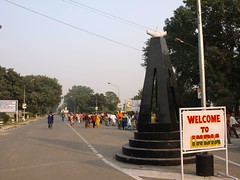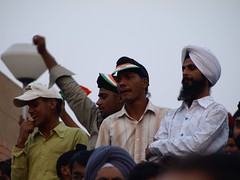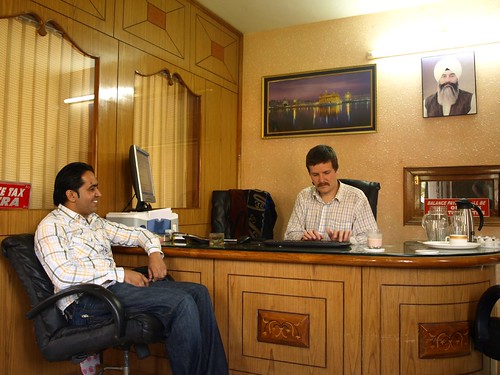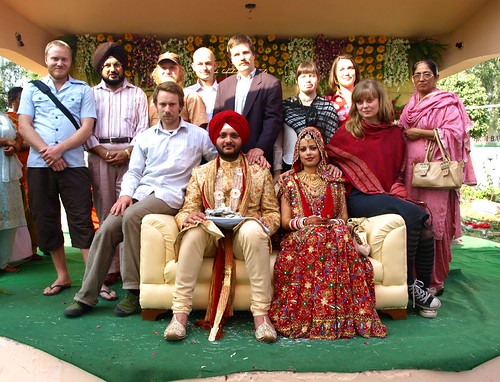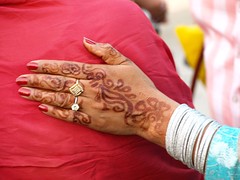-Etter en uke på indisk vei.
Det er egentlig ikke mye å utsette på de indiske hovedveiene. Vi kjører Grand Trunk Road og East West Corridor. Det er mange filer, flate og rette strekk, jevn og fresh asfalt, midtdeler, hvite striper. Deler av veien kunne lett sikra seg pallplass over turens beste veier. Allikevel har jeg sjeldent blitt så forbanna som når jeg kjører buss i India.
Det er ikke dét at vi må kjøre på feil side av veien og motsatt vei i rundkjøringer.
Det er ikke dét at inderne er gjerrige med veiskilting.
Og det er heller ikke dét å venne seg til å bruke tute som kommunikasjonsmiddel i en trafikk hvor de færreste tunge kjøretøy har speil. Vi har det moro med vår nye ansvarspost foran i bussen.



Rollen som ekstratute. Her er BK i aksjon.
Uansett størrelse på veien, den er for alle. Sykler, mopeder og motorsykler lasta med hele familier fra bestemor til bebis, autorickshaws og traktorer med enorme hengerlass uten nevneverdig sikring. Kuer gresser hellige over alt. Esel og vogn, hest og vogn, vannbøffel og vogn, dromedar og vogn, biler, lastebiler med lasteplanet fullt av stirrende indere og busser som kjører som sinnssyke.
Jeg spør en inder om hvordan det er med vikeplikt og sånn. Vike fra venstre her, kanskje? Han ler. Det er ingen regler her. I hvert fall ingen som følger dem.
Våre kollegaer bussjåførene er de værste uansvarlige svina, hakk i hæl kommer lastebilsjåførene og bilistene virker heller ikke redde. Her er det ikke snakk om å beregne god plass for å foreta en forbikjøring. Bare det er akkurat plass nok. Det blåses i skrikende horn og gis blankt faen i esler, sykler og norske busser. Andre må bremse, andre må pelle seg, gjerne av veien. Det er som et bilspill hvor det er bonuspoeng i hver eneste forbikjøring og alle har lomma full av ekstraliv. Folk brenner etter å komme seg til neste brett, hva nå det måtte innebære. Fra mitt raseri får jeg lett mistanke om at det å kjøre så hensynsløst har en sammenheng med å tro på reinkarnasjon og at livet aldri kan verdsettes like høyt her som hjemme i gode Norge.
To ganger på seks dager får vi blåst av speila på høyre side. Begge ganger av lastebiler i avsindige forbikjøringer. Første gang har vi ingen reservespeil. og uten speil er vi blind elefant i barnehage. Speilekspedisjon utsendes med autorickshaw og kommer tilbake halvannen time seinere med nytt speil og ekstraspeil(som vi får bruk for to dager seinere).
Å slappe av med midtdeler, er ingen god idé. Med midtdeler er det nemlig ikke sagt at all trafikken på din side går samme vei. Når man ligger som best i 80 uten en eneste bekymring fordi veien er god og ganske trafikkløs, kommer det plutselig en traktor med et optimistisk duvende høylass kjørende imot.
Likevel må jeg bittert innse at folk faktisk er vanvittig gode til å kjøre på akkurat denne måten og det går opp for meg at det kanskje kan være mitt sinne og min nervøse fislekjøring som utgjør den største faren her.
Etter en uke på indisk vei, har vi allikevel tilpassa oss aldri så lite. Når jeg nå drar hjem til jul er jeg spent på hvordan det blir å kjøre bil. Hvem veit om jeg uten å tenke over det kommer til å stå på tuta mens jeg foretar hårfine forbikjøringer mellom Seljord og Bø?

